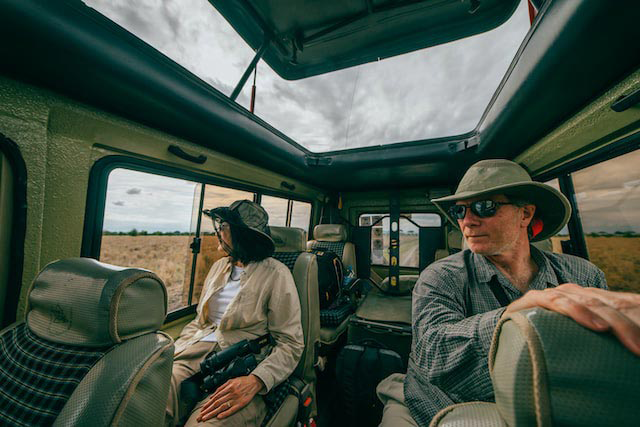
What to Wear on Safari
After making a safari reservation, one of the first queries individuals have is what to wear on Safari. As a result, we have created some straightforward instructions to assist you.
What to Wear on Safari: Recommendations
Layers are a good idea because the temperature may change quite a bit. Pack thin clothing that you can easily double up as needed.
Comfortable footwear is a must; hiking boots are not necessary unless you are going on a walking safari. You should still wear comfy shoes, though. When you are out and about, closed toes are ideal. Open-toe sandals or robust flip-flops might be a decent choice if you're on a safari involving a vehicle.
A lightweight hat will shield you from the sun, which can be harsh. To assist you in keeping the sun out of your eyes, choose a hat with a brim.
In the mornings and nights, a thin scarf can help keep flies at bay and your neck warm.
Sunglasses are necessary! Try to get UV-protective, decent-quality sunglasses.
Avoid wearing dark, black, or blue clothing and go for light, neutral hues. They should avoid bright designs since they draw mosquitoes, attracting certain insects. There is a solid reason why the majority of safari attire is beige, sand, and khaki.
You'll be in and out of cars and the woods, so wear easy-care clothing. Therefore, worrying about clothing that has complicated care instructions is the last thing you need. Choose clothing that is easy to wash and dry and won't wrinkle easily.
Look at your schedule. Comfort is important. How long do you expect to be travelling each day? Consider how your clothing will feel after that time. Get rid of everything that irritates you or gives you a bad feeling.
Sports bra, for real. Some of the roads can become rocky. You will appreciate the extra support we provide when you are bouncing along.
If your camps feature pools, make sure you carry the appropriate attire.
You may keep yourself covered by wearing long clothing, such as long sleeves, pants, or long skirts or shorts. It will offer some degree of defence from the sun and insects. However, you will still need to take bug repellent; this is not a substitute.
What to Wear on Safaris (Continued)
Even while the daytime temperature in Africa in the winter may be a lovely 25 degrees, the nighttime temperature might drop significantly, so you might want to carry some warmer layers like a fleece or light sweater.
To prevent the weather from ruining your trip, you should carry a raincoat while travelling during the rainy season. Tanzania's rainy seasons are from November through January and March through May.
You may wish to bring a thick hat if you get chilly easily, especially if you have any early morning game drives. You will always have more fun if you are not shivering. To keep you warm, many of the sites, however, provide blankets for the automobile.
Does a safari require you to wear neutral colours?
Yes, you should conceal yourself if you're going on a walking safari. White is too high in contrast and can be quite apparent to animals, and because you will be entering their domain, you don't want to startle or frighten them. Since many animals lack colour vision, it is important to focus on the intensity of the colour rather than the shade.
There are still solid reasons to keep to neutrals even on a safari if you are going on game drives, even though it is not quite as crucial to choose from a neutral palette. White clothing may become a little soiled. Additionally, it would be best to steer clear of black and other dark hues since they might draw Tsetse flies, which have a terrible and painful bite.
How not to dress for a safari
If you want a stress-free and fun safari, there are a few more things to avoid. Take off your jeans; not only will you be far too hot, but denim takes a long to dry if you get wet.
Another no is wearing garments with camouflage prints. It is not a popular option in Africa because it is often only worn by military personnel, so it will likely attract unwelcome attention, especially at airports or border crossings.
High heels are not practical and won't be worn much on Safari when you are out and about and in the evenings. In addition, you won't need rugged hiking boots unless you are on a safari that requires a lot of walking.
What not to wear on Safari
If you want a stress-free and fun safari, there are a few more things to avoid. Take off your jeans; not only will you be far too hot, but denim takes a long to dry if you get wet.
Another no is wearing garments with camouflage prints. It is not a popular option in Africa because it is often only worn by military personnel, so it will likely attract unwelcome attention, especially at airports or border crossings.
High heels are not practical and won't be worn much on Safari when you are out and about and in the evenings. In addition, you won't need rugged hiking boots unless you are on a safari that requires a lot of walking.
Safari Luggage Guide
There will be certain limitations on the amount of luggage you may bring while travelling between camps or locations. Soft-sided bags should always be brought because there is not much room. Additionally, pay particular attention to the weight restrictions you are given. Small internal African planes have stringent weight restrictions, often 15 kg, so always stay under the limitations.
Tanzania Wildlife Safari Packages
Read more on What to Wear on Safari
What to wear on Safari is an article to guide our guests about the kind of clothes and the colour to choose for a safari.
